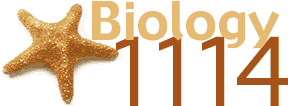|
Return
to Biology 1114 Index Page

Preview
Material for Exam 4 - Spring 2011
Print
the PDF version (no pictures, better printing)
Remember:
Use a #2 pencil to fill in the information on your NCS answer sheet. Put your O-Key Account Username in the boxes indicated for LAST NAME and darken the appropriate circles. Write your Name (Last, First) and “Star” in the space above the boxes containing your O-Key Account Username. Darken the (S) in the last column of the name circles. Enter the number 1114 and darken the corresponding circles in the first 4 columns of the “Student ID.” Failure to perform this correctly will incur a -10pt handling fee. Read all questions and answers carefully before choosing the single BEST response for each question. Feel free to ask the instructor for clarification. You may only use the calculator provided during the test.
| |
important equations: r = b – d G = r N G = r N [ (K-N)/K ]
You may only use the calculator provided during the test!!! |
The scientist in a winery is assigned the task of determining which sugar is best to add to the grapes to speed the alcohol formation by yeast. The scientist is supplied with three sugars – glucose, fructose, and sucrose. Glucose and fructose are both simple 6- carbon sugars (C6H12O6). Sucrose is made by combining glucose and fructose to make a 12-carbon sugar (C12H10O5). The scientist sets up four containers to run the test as follows:
| |
1 |
2 |
3 |
4 |
Water |
Glucose |
Fructose |
Sucrose |
Yeast |
Yeast |
Yeast |
Yeast |
|
 source source |
While the many species of tortoises and finches on the Galapagos islands are famous, there are many other unique sets of species on those islands. In 2009, Drs. Parent and Crespi studied land snails in the genus Bulimulus and found some seventy endemic species (i.e. found no where else). |
Tay Sachs is an autosomal recessive disease caused by a mutation in the HEX A gene. The disease results in the inability to produce Hexosaminidase A, which breakdown gangliosides. Gangliosides are necessary during development but result in neurological disorders and death by age 4 if they accumulate. |
|
 source source |
Siscowet trout are native to Lake Superior. Compared to Lean trout, Siscowet trout are unique in that they are naturally obese (containing up to 70% body fat). They swim in the deeper waters (~1000 ft) of Lake Superior and eat herring. In the absence of herring they directly eat the food of herring, freshwater shrimp. Trout have well developed vision, including four types of cone cells. Siscowet trouts were a delicacy among the Ojibwe due to high content of essential fatty acids, and ease of cooking. However, the Great Lakes Fisheries Commission (GLFC) has advised against consuming Siscowet trout for the last few decades due to high amounts of fat-soluble contaminants (e.g., PCB) that have runoff into the lake from industries.
Pesticides such as Chlorpyrifos in the area surrounding Lake Superior eventually runoff into the lake. A Minnesota Fisheries official wants to determine whether such runoff affects Siscowet trout. She collects similar-aged and -sized Siscowets from the lake and exposes them to varying concentrations of Chlorpyrifos, and measures fish respiration, growth, and other vital signs. ) Lake Erie has a longer history of Chlorpyrifos runoff, and higher Chlorpyrifos concentrations. A Fisheries official in Ohio conducts a similar experiment and finds that Siscowet trout in Lake Erie are not affected by Chlorpyrifos presence. She determines that Erie Siscowets have evolved resistance to Chlorpyrifos.
Both the hypothalamus and the pituitary gland are vital to the control of your body’s metabolism because of the variety of hormones they secrete. The hypothalamus secretes vasopressin, which can elevate blood pressure by stimulating contraction of muscles surrounding arteries. The hormone vasopressin promotes the reabsorption of water by the kidney. The lack of vasopressin secretion causes a syndrome known as diabetes insipidus—resulting from the inability of the kidney to reabsorb water. The anterior pituitary gland includes among its secretions thyroid stimulating hormone [TSH]. This hormone stimulates thyroxin secretion from the thyroid gland.
 |
After the recent Tsunami struck the coastal scrubland in which a population of California mice were living, 4 pairs of mice were washed away to one of the small coastal islands. |
|